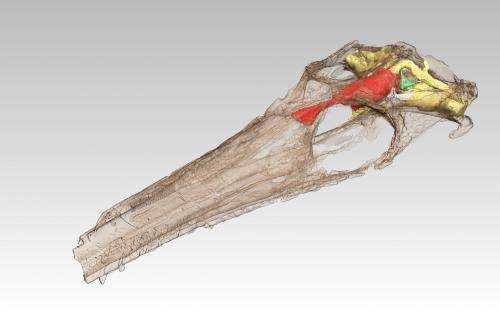A word in your ear, but make it snappy

To most, crocodiles conjure images of sharp teeth, powerful jaws and ferocious, predatory displays – but they are certainly not famous for their hearing abilities. However, this could all change, as new research is shedding light on the reptiles' ears, showcasing their evolution from the reign of the dinosaurs to the era of Crocodile Dundee.
Dr Felipe Montefeltro is currently undertaking research into the otic region of fossilised crocodyliforms at the University of Birmingham as part of a three month postdoctoral fellowship.
Crocodiles have been around in one form or another for 200 million years but little is known about the evolution of their ears during this time. Along with concurrent research, Dr Montefeltro's work could also provide clues as to why the reptiles have survived for so long, whilst other creatures such as dinosaurs died out.
Dr Montefeltro's work sees him initially dissect ears from extant crocodilians to understand the morphology of these structures. The second step sees him compare the information from the extant species to as many fossil groups as possible to determine the evolutionary implications of the observed variation.
A key approach used by Dr Montefeltro in this work is computed tomography (CT), which allows him to virtually peer inside fossil skulls and examine details of the ear anatomy that would otherwise be completely inaccessible. For example, whilst based at the University of Birmingham, Dr Montefeltro has gained unprecedented access to the CT scan of a superbly preserved skull of an aquatic crocodilian that is part of the collection in the Natural History Museum, London.

The habitats of crocodilians have changed throughout time, as they have shifted from aquatic to terrestrial environments and vice-versa. Dr Montefeltro's research already suggests that water and land-based crocodilians relied on very different types of hearing. Modern, semi-aquatic crocodilians depend heavily on their hearing for hunting and communication. Their ears are unique among vertebrates, as their tympanic membranes are concealed by flat flaps that can be raised or lowered by muscles. Crocodiles vocalise when in distress and during aggressive behaviour, yet the reception of underwater sounds is also important for them in social communication. Dr Montefeltro's research will focus on the structures of crocodile ears throughout time. For example, the ear as a whole (outer, medium and inner) is more developed in terrestrial species, and less developed in aquatic species.
Along with birds, crocodilians are the only living representatives of the archosaurs; a group which includes dinosaurs and pterosaurs. 200 million years ago, crocodiles roamed Dr Montefeltro's native Brazil and there remains a plethora of ancient crocodilian species to be discovered in his homeland. Dr Montefeltro hopes new discoveries in Brazil will feed into his research as they are uncovered. He returns to Brazil later this month to continue his work at São Paulo State University, where he is a postdoctoral researcher.
Dr Felipe Montefeltro said: "Crocodilians first appeared more than 200 million years ago and during this long history many subgroups have shifted from terrestrial to aquatic habitats and probably the other way around. Thus, crocodilians are an attractive model to study evolution driven by habitat changes, such as the development of sensorial organs, like ears."
Dr Richard Butler, Birmingham Fellow, School of Geography, Earth and Environmental Sciences at the University of Birmingham is a leading vertebrate palaeontologist who has been working with Dr Montefeltro during his time in the UK. He said:
"Fossil crocodilians are fascinating because they were incredibly diverse, and occupied a whole range of environments and ecologies that we just don't see today. Felipe's research is providing us with important new insights into the biology and evolution of those extinct crocodilians that occupied extreme ecological niches."
Provided by University of Birmingham





















